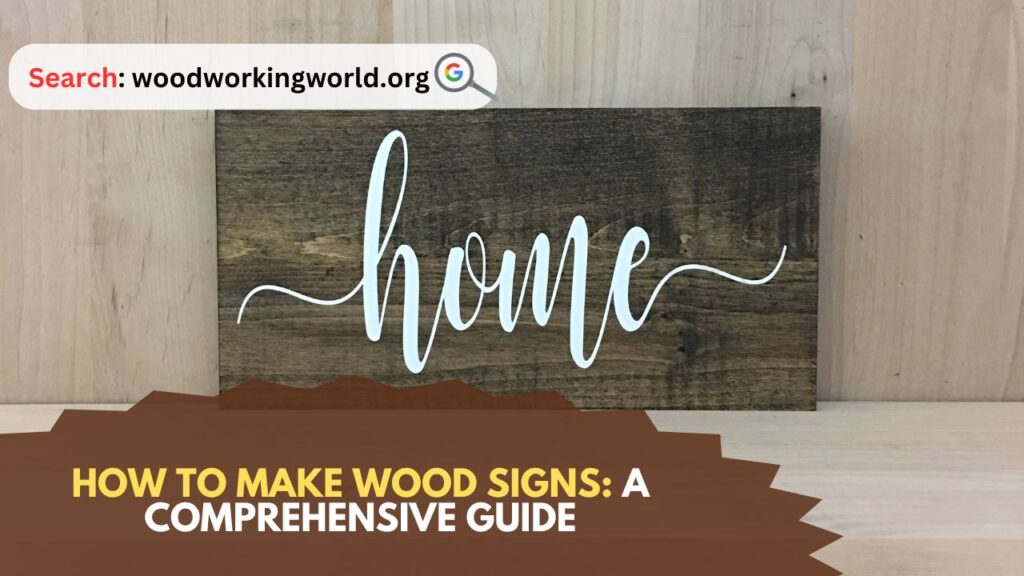Wood Signs: Creating your own wood signs can be a fun and rewarding project that adds a personalized touch to your home décor, events, or business. Whether you want a rustic welcome sign for your front porch, a chic menu board for your café, or a whimsical piece of art for your child’s room, making wood signs allows you to unleash your creativity and craftsmanship. This comprehensive guide will walk you through the steps and techniques to craft beautiful wood signs that you can proudly display or gift to others.

How to Make Wood Signs
Materials and Tools Needed
Before you start, gather the following materials and tools:
Materials:
- Wood boards (pine, cedar, or reclaimed wood are popular choices)
- Sandpaper (120 and 220 grit)
- Wood stain or paint
- Painter’s tape
- Stencils or transfer paper
- Acrylic paint or wood stain
- Clear sealant (polyurethane or wax)
- Hooks, sawtooth hangers, or twine (for hanging)
Tools:
- Measuring tape
- Pencil
- Circular saw or hand saw
- Electric sander or sanding block
- Paintbrushes (various sizes)
- Foam brushes
- Rags or paper towels
- Screwdriver or drill
Step-by-Step Instructions
- Choose and Prepare Your Wood:
Select a wood board that suits the size and style of the sign you want to create. Pine is an affordable and easy-to-work-with option, while cedar offers a more rustic look. Reclaimed wood can add character and history to your project. Use a circular saw or hand saw to cut the board to your desired dimensions. Sand the edges and surface of the wood with 120-grit sandpaper to smooth out any rough spots, then finish with 220-grit sandpaper for a fine finish. - Stain or Paint the Wood:
Decide whether you want a stained or painted background for your sign. If staining, apply the wood stain using a foam brush or rag, following the wood grain. Allow the stain to penetrate for a few minutes before wiping off the excess with a clean rag. Let it dry according to the manufacturer’s instructions. If painting, use painter’s tape to mask off any areas you want to keep natural or a different color. Apply acrylic paint with a paintbrush or foam brush, using long, even strokes. Allow the paint to dry completely before proceeding. - Plan Your Design:
Sketch your design on paper or use a design software to create a digital template. Consider the font style, size, and placement of any text or images. Stencils can be helpful for intricate designs, while transfer paper allows you to trace more detailed artwork onto the wood. - Transfer or Stencil Your Design:
If using stencils, tape them securely onto the wood. Use a pencil or a fine-tipped brush to trace the outlines of the design onto the wood. For transfer paper, place it graphite-side down on the wood and tape your printed design on top. Trace over the lines of your design with a pencil or pen, applying firm pressure to transfer the graphite onto the wood. - Paint or Stain Your Design:
Use small paint brushes to fill in your traced design with acrylic paint or wood stain. Work carefully to stay within the lines, applying multiple coats if necessary for a vibrant finish. Allow each coat to dry before applying the next. - Add Finishing Touches:
Once your design is complete and fully dry, you can add additional details or embellishments, such as distressing the edges for a vintage look or adding decorative elements like knobs, hooks, or faux flowers. - Seal and Protect Your Sign:
Apply a clear sealant to protect your sign from wear and the elements. Polyurethane is a durable option for indoor and outdoor signs, while wax can give a softer, more matte finish. Apply the sealant with a foam brush or rag, following the wood grain, and allow it to dry completely. - Attach Hanging Hardware:
Depending on how you plan to display your sign, attach hooks, sawtooth hangers, or twine to the back. Use a screwdriver or drill to secure the hardware firmly.
Tips and Tricks for Perfect Wood Signs
- Choosing the Right Wood: Softwoods like pine and cedar are easier to work with and more forgiving for beginners. Hardwoods like oak and maple are more durable but require more effort to cut and sand.
- Sanding is Essential: Proper sanding ensures a smooth surface for staining or painting and prevents splinters. Always sand with the grain of the wood for the best results.
- Staining Tips: Test your stain on a scrap piece of wood to see how it looks before applying it to your sign. Remember that the final color can vary depending on the wood type and how long you leave the stain on before wiping.
- Painting Precision: Use painter’s tape to mask off areas and achieve clean, straight lines. Small, fine-tipped brushes are ideal for detailed work.
- Lettering and Fonts: For crisp lettering, consider using adhesive vinyl stencils or printable vinyl sheets that you can cut with a craft cutter. This method can save time and provide professional-looking results.
- Distressing Techniques: To achieve a weathered, rustic look, lightly sand the edges and surface of your painted sign after it dries. You can also use a dry brush technique with a contrasting paint color for added texture.
- Sealant Application: Apply sealant in thin, even coats to avoid drips and bubbles. Lightly sand between coats with fine-grit sandpaper for a smooth finish.
- Weatherproofing: For outdoor signs, use exterior-grade paint and sealant to protect against the elements. Ensure all edges and corners are well-sealed to prevent moisture from seeping in.
Creative Ideas for Wood Signs
- Welcome Signs: Create a warm and inviting atmosphere with a personalized welcome sign for your front porch or entryway. Add your family name or a friendly message like “Home Sweet Home.”
- Kitchen and Dining: Make a menu board, recipe sign, or quirky kitchen quotes to add charm to your cooking space. Use food-related themes and colors that match your kitchen décor.
- Children’s Rooms: Craft playful signs with your child’s name, favorite quotes, or whimsical images like animals or stars. Choose bright, fun colors to match the room’s theme.
- Holiday Décor: Create seasonal signs for holidays like Christmas, Halloween, or Easter. Use festive colors and motifs to celebrate the season and bring joy to your home.
- Business Signs: Design professional-looking signs for your business, such as open/closed signs, directional signs, or promotional boards. Use your brand colors and logo for consistency.
- Inspirational Quotes: Make motivational signs with your favorite quotes or sayings. These can be great for home offices, living rooms, or as thoughtful gifts.
Conclusion: Wood Signs
Making wood signs is a versatile and enjoyable craft that allows you to express your creativity and add a personal touch to any space. With the right materials, tools, and techniques, you can create beautiful, customized signs for any occasion or setting. Whether you’re a seasoned DIY enthusiast or a beginner looking for a new project, this guide provides everything you need to get started on your wood sign-making journey. Happy crafting!
I hope this article on Wood Signs has been helpful. If you have any further questions, please feel free to leave a comment below.
Video
